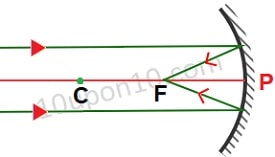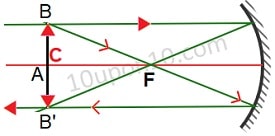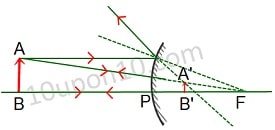Sample Paper: Term-1:2021-22 - Class 10th Science
Science Term-1 MCQs:B
Question (11) After surgical removal of the infected gall bladder of Amit, doctor advised him to restrict dietary intake of fats.
Where does digestion of fats take place in the human body?
(A) Liver
(B) Gall bladder
(C) Stomach
(D) Small intestine
Answer (D) Small intestine
Explanation
The fats found in food are present in the form of large globules. The action of enzymes is difficult on large globules. The gall bladder secretes bile juice which acts on fat and break it in smaller globules this increase the efficiency of enzyme action on them.
And hence the digestion of fats take place in the small intestine.
This is the cause that after surgical removal of the infected gall bladder, doctor advised to restrict the dietary intake of fats.
Here, the option (D) Small intestine is the correct answer.
Question (12) The diagram shows the human gut. Which numbered structures secrete digestive enzyme?

(A) 1, 2, 3 and 4
(B) 1, 2, 3 and 6
(C) 1, 3, 4 and 5
(D) 2, 3, 5 and 6
Answer (A) 1, 3, 4 and 5
Explanation
There is no digestion taken place in the esophagus.
Hence, option (C) 1, 3, 4 and 5 is the correct answer.
Question (13) The leaves of a plant first prepare food A by the process of photosynthesis, the food which is not used immediately in the form of B. Identify A and B respectively.
(A) Amino Acid and starch
(B) Glucose and Glycogen
(C) Glucose and Fatty acids
(D) Glucose and Starch
Answer (D) Glucose and Starch
Explanation
In the course of photosynthesis, plants prepare food in the form of Glucose. This prepared glucose is used by various parts of plants. The glucose left, i.e. unused, is stored in the form of starch.
Thus, the correct answer is option (D) Glucose and Startch.
Question (14) Plants use a completely different process for excretion as compared to animals. Which one of the following processes in NOT followed by plants for excretion?
(A) They can get rid of excess water by transpiration.
(B) They excrete substances into the soil around them.
(C) Waste products are stored as resins and gums in old xylem.
(D) They get rid waste substances through excretory organs.
Answer (D)They get rid waste substances through excretory organs.
Explanation
Excretory organs are not found in plants they are found in animals.
Question (15) Which is the correct sequence of air passage during inhalation?
(A) Nostril → larynx → pharynx → trachea → lungs
(B) Nostril → pharynx → larynx → trachea → alveoli
(C) Nasal passage → trachea → pharynx → larynx→ alveoli
(D) larynx → nostrils → pharynx → lungs
Answer (B) Nostril → pharynx → larynx → trachea → alveoli
Explanation
Human takes air thorough nostrils. After that it passes to pharynx, then larynx, then trachea and then alveoli present in the lungs.
Thus, the correct sequence is (B) Nostril → pharynx → larynx → trachea → alveoli
Question (16) Rohan experienced muscular cramps during the training session for his upcoming football match. His coach advised him on a schedule of aerobic exercises to overcome this problem. Rohan followed his coach’s advice and did not experience any muscular cramps during the game.
Lack of oxygen in muscles often leads to cramps due to ______
(A) Conversion of pyruvate to ethanol
(B) Non conversion of glucose to pyruvate
(C) Conversion of pyruvate to lactic acid
(D) Conversion of pyruvate to glucose.
Answer (C) Conversion of pyruvate to lactic acid
Explanation
Oxygen taken while inhalation is used in respiration at cellular level. Cells take this oxygen and break down the glucose in pyruvate. This pyruvate is broken down into carbon dioxide and water and release energy. The energy so released is used for different works. This is called Aerobic Respiration.
Some time because of more works, enough oxygen is not reached at the cellular level and respiration is started taking place in the absence of air to release of energy.
In this situation, pyruvate is broken down and form lactic acid and energy.
This is called Anaerobic Respiration.
Thus, the correct answer is option (C) Conversion of pyruvate to lactic acid.
Question (17) A child is standing in front of a magic mirror. She finds the image of her head smaller, the middle portion of the body of the same size and that of the legs bigger. The following is the order of combinations for the mirror from the top.
(A) Plane, convex and concave
(B) Convex, concave and plane
(C) Concave, plane and convex
(D) Convex, plane and concave
Answer (D) Convex, plane and concave
Explanation
The convex mirror always makes the image smaller than the object as her head appeared be small so, the first mirror is convex.
The plane mirror forms image of same size. Since, the middle portion remained same thus the second, i.e. in the middle there is a plane mirror.
The concave mirror forms a virtual imager bigger than the object when an object is placed between focus and pole. So, the last is a concave mirror.
Hence, option (D) Convex, plane and concave is the correct answer.
Question (18) Rays from the sun converge at a point 12cm in front of a concave mirror. Where should an object be placed so that the size of its image is equal to the size of the object?
(A) 12 cm in front of the mirror
(B) 24 cm in the front of the mirror
(C) Between 12 cm and 24 cm in the front of the mirror
(D) More than 24 cm in the front of the mirror
Answer (B) 24 cm in the front of the mirror
Explanation
In a concave mirror rays coming from infinity passes parallel to principal axis and converge at focus.

Since, the rays coming from the sun are parallel to the principal axis and converge at 12 cm in front of the mirror so, this point is the focus and mirror is a concave mirror.
In a concave mirror when object is placed at the centre of curvature, a same size inverted real image is formed at the centre of curvature, i.e. at C. And we know that C = 2F.

Here, since F = 12 cm, so when will be placed at 2F, i.e. 12 × 2 cm = 24 cm, a same sized inverted image will be formed at the same place.
Thus, option (B) 24 cm in the front of the mirror is the correct answer.
Question (19) A spherical mirror and a thin spherical lens have a magnification m= 0.7. the mirror and lens are likely to be:
(A) Both concave
(B) Both Convex
(C) The mirror is convex and the lens is concave
(D) The mirror is concave and the lens is convex
Answer (C) The mirror is convex and the lens is concave
Explanation
Here, given m = 0.7
This means the image is smaller than the image and the value is positive. Positive magnification means image is erected.
In the case of a convex mirror and a concave lens, erect and smaller images than objects are formed.
Thus, the mirror is a convex and lens is concave.
Therefore, option (C) The mirror is convex and the lens is concave is the correct answer.
Question (20) Simmi placed a juice bottle at a distance of 20 cm in front of a convex mirror which has a focal length of 20 cm. Where is the image likely to form?
(A) At focus behind the mirror
(B) Focus in front of the mirror
(C) At a distance of 10 cm behind the mirror
(D) At a distance of 10 cm in front of the mirror
Answer (C) At a distance of 10 cm behind the mirror
Explanation
(C) Because the bottle is not at infinity so, the image will not form on focus
The object is 20 cm in front of convex mirror and if object is as Principle axis the image always form before F

∴ the correct answer is option (C) At a distance of 10 cm behind the mirror